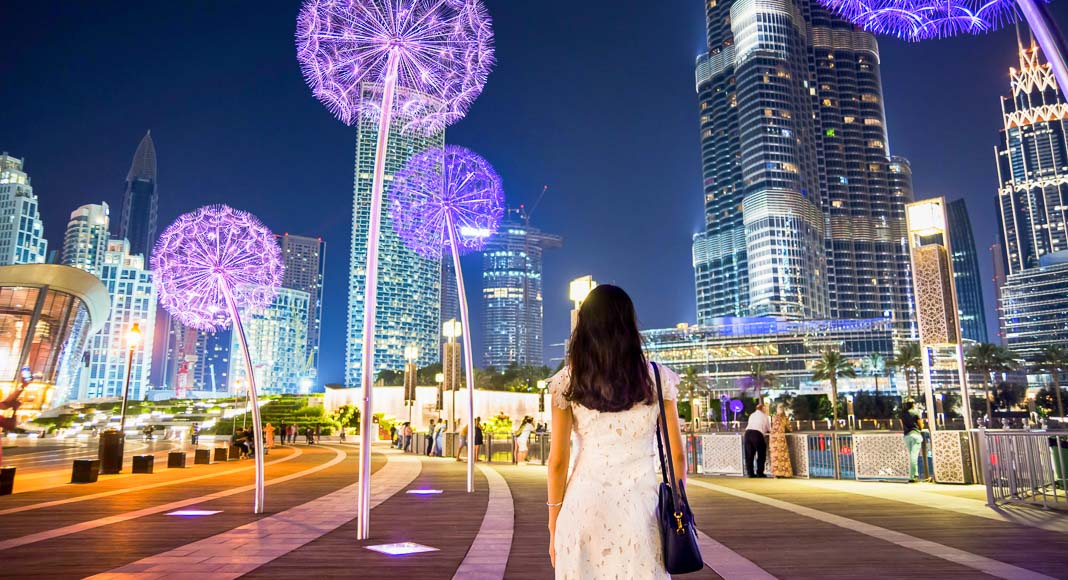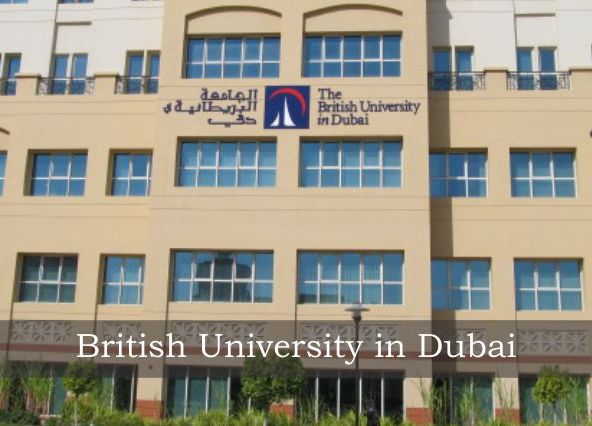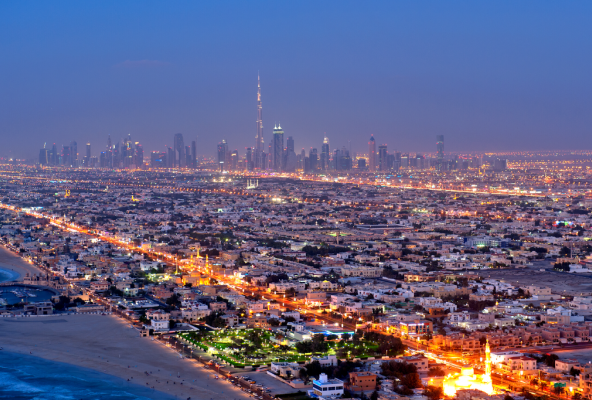Dubai, often called Dubayy, is the capital and largest city of the emirate of Dubai, one of the wealthiest of the seven emirates that make up the United Arab Emirates, which gained independence from the United Kingdom in 1971. The origin of the name Dubai is the subject of various theories. Some believe it alludes to a market that once existed near the city, while others believe it relates to the daba, a type of locust that infests the area. Dubai has been likened to Singapore and Hong Kong in recent years, and is frequently recognized as the Middle East’s premier entrepôt. 13.5 square miles in size (35 square km). 2,919,178 people (as of 2017).
Dubai is a skyscraper-studded city with ports and beaches, where big business coexists with sun-seeking tourism. It has the feel of a Middle Eastern melting pot due to its big expatriate population, and the atmosphere is generally tolerant. Religious affiliations are not a big deal in the city. Although Islam is the majority religion, Dubai’s mosques coexist with churches and Hindu temples.
Dubai is a largely crime-free city that has experienced phenomenal growth because to administrative efficiency and business openness. However, criticizing Dubai’s authoritarian government and ruling elite is not permitted, and a culture of covert corruption remains.
Landscape:
Small expanses of sandy beaches in Dubai’s western section have aided the city’s tourism economy. Dubai’s rulers wanted to expand the city’s restricted seafronts, therefore developers were urged to build massive man-made islands off the city’s coast in the absence of natural offshore islands. The most well-known is Palm Jumeirah, which is shaped like a palm tree. Others include the “World” islands, a group of small islands that, when viewed from above, resemble a world map.
On the southern borders of the Persian Gulf, Dubai straddles a natural inlet known as Dubai Creek. Because the early city’s emphasis on fishing, pearl diving, and maritime trade, the area was Dubai’s centre for more than a century. The oldest buildings in Dubai line the creek, the majority of which date from the 1960s and are rarely more than two stories tall. Some much older buildings have been renovated in the Bastakiyyah area, on the western bank of the creek, and many of these include the characteristic wind tower architecture that was introduced by Persian merchants early in the twentieth century.
Sheikh Zayed Road is lined with skyscrapers, forming the new city centre. The Emirates Towers, which were built in the late 1990s and early 2000s and house a hotel and government offices, are notable. The Dubai International Financial Centre, housed in a futuristic arch-shaped building, is close to Sheikh Zayed Road, as is the Burj Khalifa, which was the world’s tallest building at the time of its official opening in 2010; it was named after the president of the United Arab Emirates and emir of Abu Dhabi, Khalifa ibn Zayed Al Nahyan. Several rich communities are to the west of the skyscrapers, the majority of which contain sizable villas. On their outskirts stands the Burj al-Arab, a massive sail-shaped skyscraper that houses a luxurious hotel. New skyscraper clusters surround a man-made harbour and three man-made lakes further west.
Climate:
Dubai, like much of the Persian Gulf coast, enjoys a hot climate all year. Summers are hot and humid, whereas the rest of the year is mild. January is normally the coldest winter month, with lows of around 15 °C (49 °F), while July is the hottest summer month, with highs of more than 40 °C (104 °F).
People:
Over the last two centuries, Dubai’s population has slowly increased, from a few thousand locals to well over two million. The majority of the early population growth was due to merchants from neighbouring nations deciding to relocate to Dubai because of its business-friendly atmosphere. The city’s construction boom in the late twentieth century resulted in a large influx of South Asian labourers, as well as skilled expats from all over the world, who play an essential role in Dubai’s multi-sector economy. Expatriates substantially outnumber Emiratis in the city. Expatriates of various countries are distributed over Dubai, with the exception of labourers, who are accommodated in work camps outside the city limits. Despite the fact that Arabic is the official language, English is the lingua franca.
Although there are large Christian, Hindu, and Sikh populations, the indigenous population is predominantly Muslim, as is the majority of the expatriate community. The diverse faiths cohabit happily because to the ruling family’s tolerance for non-Muslims and the city’s focus on business, though there have been cases where foreign immigrants have disobeyed decency laws or drug-use prohibitions’ substantial Christian, Hindu, and Sikh communities
Economy:
Dubai’s economy is not built on oil, contrary to popular misconception. Between the 1960s and the 1990s, the little oil revenue it did have was used to improve other sectors of the economy by constructing physical infrastructure. Dubai’s economy is still based on trade, with two of the world’s largest ports and a thriving international aviation freight hub. The Jebel Ali free-trade zone was formed in the 1980s to encourage industrial investment; it is home to aluminium smelting, automobile manufacturing, and other industries.
Transport:
Dubai is not a friendly city for pedestrians, with large freeways, a hot climate, and a year-round dependency on air conditioning, so automobile traffic can be highly severe. New bridges, highways, and a fully automated, driverless metro rail system have lessened the hassles of getting around the city in the early twenty-first century. The Dubai-owned airline Emirates, which operates a big and modern fleet of aircraft, has had a significant impact on tourism.
Municipality:
Dubai Municipality is one of the country’s largest government institutions. It is overseen by a director general, who reports to the chairman of Dubai Municipality, who is a member of the ruling family. The director general is in charge of six sectors and 34 departments, totalling around 11,000 employees. The municipality not only oversees city services, but it is also a major contributor to the emirate’s economic growth.
Services provided by the municipality:
Although Dubai’s energy and water supplies have largely kept pace with the city’s population expansion, some services, such as rubbish collection, have been criticized for falling behind. Parks and public spaces have been intensively built and maintained, with the city’s green space significantly increasing in the 2010s.
Education:
There are two types of education: private and public. The majority of public schools and all universities educate in English, whereas the majority of private schools and all institutions teach in Arabic. The American University in Dubai (1995) and Zayed University (1998) are two local universities with a solid reputation. The majority of the employees are from other countries, with a sizable contingent from North America.
History:
The city flourished quickly as it became a significant centre of the pearl-diving business, from humble origins as a little fishing village first attested in the 18th century. The city flourished further in the early twentieth century as its business-savvy ruling family reduced taxes and welcomed foreign merchants, and it soon became a re-exporting hub for Persia and India. All of these jobs required highly educated foreign workers, and many of them relocated to Dubai for the tax-free wages and relatively stable
political environment. With expats from all over the Arab world, as well as Asia, Europe, and North America, the city gained a cosmopolitan feel and was regarded as having one of the region’s most open communities.




